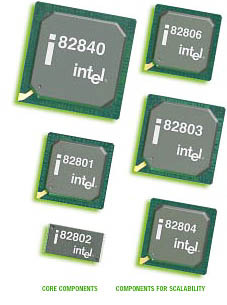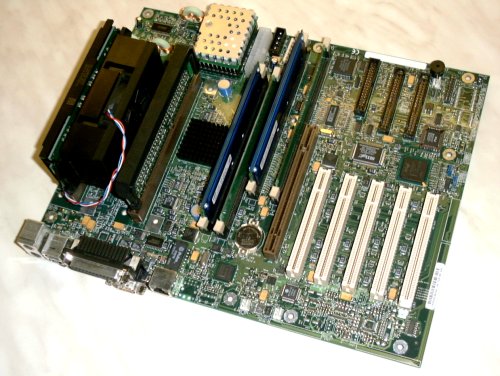The RDRAM Avenger - Intel's i840 Chipset
Introduction
It is more than six weeks ago now. One day after Intel released its new Coppermine processor-core, exactly on October 26, 1999, I received an email from a member of Intel's Customer Support who is working in the Server-Division. The mail was nice and polite, but stated that if I really would want to see Coppermine's performance, I should run this new CPU on a platform with Intel's i840-chipset, particularly on the 'OR840'-motherboard from Intel. The sender stated that this is his personal opinion and not Intel's (every Intel-employee is very careful about that) and noted that he will try and get an OR840 for himself as soon as it is available.
It was that day when I started to dig for one of those mystical 'OR840'-boards, or at least another motherboard with this shiny new i840-chipset, that looked so much better than the 'tainted' i820.
The Intel 840 Chipset
The i840 is actually a 'workstation'-chipset and the designated successor of the 440GX-chipset. Due to this, you won't find i840 on mainstream motherboards right now and Intel doesn't really like anyone to talk about i840, who does not address workstation users. However, looking at i840's features and its differences to i820, the RDRAM-mainstream chipset, make i840 appear rather attractive to anyone who wants to use a Coppermine-processor.
On the first look i840 isn't really that different to i820. Both chipsets share the RDRAM-support, AGP4x, the 'accelerated hub architecture' with the 82801 I/O Controller Hub (ICH), ATA66-support, dual CPU-support, and both chipsets sport the 133 MHz front side bus. So far both are the same; the difference are the added features of i840:
- Dual memory channels , operating in lock-step, provide up to 3.2 GB/s of memory bandwidth. Thus i840 has double the memory bandwidth of i820, which is a rather huge difference. The two memory channels can also reduce latency, so that i840's memory interface is way better than i820's. Additional to that, i840 supports up to 2 GB of memory, also double of what i820 can be equipped with.
- Using the optional 82803 RDRAM-based memory repeater hub (MRH-R) or 82804 SDRAM-based memory repeater hub (MRH-S) increases i840's memory capacity even further , but the current cost of RDRAM and the performance loss of using SDRAM with either i820 or i840 doesn't make this option look particularly attractive.
- i840 comes with a special prefetch cache , allowing more efficient data flow and improving system concurrency.
- The optional 82806 64-bit PCI Controller Hub (P64H) supports 64-bit PCI slots at speeds of either 33 or 66 MHz . The P64H connects directly to the MCH using Intel Accelerated Hub Architecture, providing a dedicated path for high performance I/O. This is a feature for workstations indeed, and you won't find it on the less sophisticated i840-motherboards. Mainstream users won't be able to take much advantage of 64-bit PCI-slots, since there's hardly any 64-bit PCI-cards available in the first place and there would also hardly be any need for a 64-bit PCI sound card or network card for normal users.
In short, the main catch of i840 is it's two RDRAM-channels versus only one RDRAM-channel of i820. This increases memory bandwidth and reduces memory latency, but you always have to plug two RDRAM-RIMMs into an i840-board. i840's prefetch cache is another advantage over i820, and you can notice that in more than just workstation software, Quake3 likes to run on i840 as well.
The Intel OR840 Motherboard
The first motherboard available with the i840-chipset is clearly Intel's OR840. It's a dual-processor motherboard and comes with 10/100Mbit-LAN adapter onboard, of course using Intel's 82995 chip. As you can see from the picture above, the OR840 is equipped with a AGP Pro50-slot. This slot hosts normal AGP-cards just as well, but it supplies additional power lines for professional graphic cards that need a lot of current. The picture shows the four RIMM-slots, always two acting as a pair for each RDRAM-channel. As already mentioned above, you need to install identical RIMMs for each channel, the board does not run with only one RIMM or two differently sized RIMMs. For my testing I plugged a terminator-module into the second 'Slot1' CPU-slot, the other one hosted a Pentium III 700 processor with Coppermine-core, overclocked to 750 MHz, or a Pentium III 733 processor, also using the Coppermine-chip inside. The rather massive voltage regulator area that you can see in the upper-middle part of the picture is obviously well designed for workstation use with components that need a lot of current, and there are some additional power-supply headers on the board as well, in case the normal ATX-power connector should not be able to supply all the current needed. As for all of the new Intel-motherboards, you won't find any ISA-slots anymore. Another interesting point is obviously the price of OR840. I was informed that this dual processor workstation board comes for about $300 or less, which is not a bad price for all the features it adds to a $100 cheaper i820-motherboard for single-processors.
The testing with OR840 ran rather smoothly, the board never crashed or showed any other sign of instability. The adjustment of the processor-speed for unlocked processors is rather funky. You don't change the multiplier in OR840's BIOS-setup, but you need to run a little DOS-program called 'speed.exe' instead. I guess that this little side note is not too interesting to most of you, because all the Pentium III-processors that are officially available will be multiplier-locked and thus there's no need for 'speed.exe'.
Get Tom's Hardware's best news and in-depth reviews, straight to your inbox.
There was one annoying thing with OR840 though, it wouldn't like a lot of graphics cards. I used NVIDIA's reference GeForce256-DDR card and it ran fine. So was the TNT2-Ultra reference card. However, no Diamond-card would run in OR840, neither the Viper V770, nor the Fire GL1. OR840 refused to even come to life with those cards. I am sure that a future BIOS-update will remedy this problem, but it kept me from running the SPECviewperf tests with the Fire GL1.
The Contestants
You need to compare, if you want a good idea of the performance of a product. I decided to compare i840 with its two brothers from Intel, the good old 440BX chipset that we all love and the i820 chipset, that many of us despise.
440BX
I guess that I don't have to say much about BX. This 100 MHz FSB chipset, using PC100 SDRAM is now more than a year old and it still performs excellent. The motherboards available with BX are all mature and running rock-stable. It's good for overclocking and hosts all a normal user needs. All in all the BX-chipset will stay for quite some time to come, because it's far from outdated and it has a lot of fans and supporters. I used my favorite BX-motherboard for this test, the Asus P3B-F .
I820
I don't really want to bore you, so I won't go on too much about i820 . There's hardly any chipset that got so much press prior to its release. First known under the code name 'Camino', it was supposed to be the first chipset to bring us the blessings of RDRAM. Now we know that RDRAM is a serious political issue in itself already, because RAMBUS, its developer, receives royalties for each sold RDRAM-module. At the same time Intel holds a lot of shares of RAMBUS and is its only real promoter. RDRAM has got a very different interface to the memory-types we are used to so far. It uses a 16-bit wide serial bus that runs at 300-400 MHz, which enables a very high memory-bandwidth but at some penalty in terms of memory-latency. RDRAM is still super-expensive, costing about $1000 for 128 MB. The RDRAM-issue may be valid for i840 as well, but i820 had and has some more problems. Intel had to delay its release, because it turned out to be unfeasible to design an i820-motherboard that offers three RIMM-slots and make sure it's stable at the same time. The crop of i820-board becoming available now has thus only got two RDRAM memory-slots. At the same time i820's performance is not exactly impressive. There are several benchmarks where BX looks at least as good as, if not even better than i820. As a summary, an i820-system is expensive due to the RDRAM-price and it doesn't even perform better than BX. However, i820 is THE mainstream chipset from Intel with support for the new Coppermine-Pentium III processors running with 133 MHz front side bus. This means that you either got to stick to 100 MHz FSB processors and use BX, or you have to go for VIA's Apollo Pro 133+ chipset, which offers 133 MHz FSB with PC133 SDRAM. You can see that Intel hopes that it can push i820 through into the market, regardless if this product is good or bad and regardless if RDRAM is ridiculously expensive or not. However, there is one alternative, the i840-chipset. Let's see if i840 is able to at least add above-average performance to the very high cost of memory, something that i820 was not able to achieve.
-
ognyanz Hi,Reply
REM: About the question "What should we see when testing the different chipsets against each other?"
Likely, or may be not, who knows.

